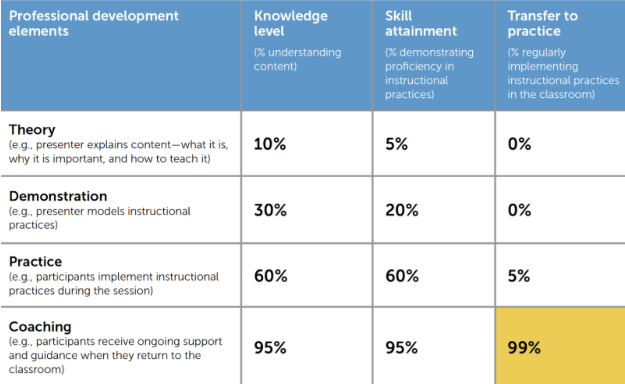Coaching Impact Amid Uncertainty: Reimagining Supportby Brianna Hodges We’ve never experienced shifts in teaching and learning quite like those happening now. With logistics, requirements, and circumstances morphing at an unimaginable speed, educators are navigating challenges that were theoretical, optional -- perhaps, barely feasible -- this time last year, have become our full-blown, full-speed, in-the-moment realities.
After all, the numbers are undeniably in favor of the holistic impact coaching has on learning, (see table, Joyce and Showers, 1982). March 2020’s sudden transition to offsite learning found edtech and instructional coaches providing around-the-clock, “25/8” assistance to help move instruction home and online. Quick to meet learning needs and accustomed to conveying initiative directives, coaches met the challenges head-on, creating, curating, and collating countless tutorials, tools, and tweets to serve and support various stakeholders, including teachers, administrators, students, and families. Yet, for many, the outpouring of well-intentioned information has actually accelerated the fuel of fear, confusion, panic, and complete overwhelm. The pandemic’s toll on educators has paralleled and, in some ways, even surpassed the stressors felt by first responders. Record numbers of resignations and early retirements intermingle with complaints of lack of support. Educators at every level, classroom and administration, are feeling inadequate, ill-prepared, unappreciated, and alone. Educators, coaches, and instructional leaders provide support, which is foundational to our work. That said, support is a variant term, meaning different things in different scenarios. How might we reimagine support so that we can better sustain educators amid extreme uncertainty? Support shouldn’t imply a solution. Nor should support be flippantly glossed over with a glancing “You got this.” The rapid and evolving circumstances associated with the virus have made only one thing certain -- change. And with no way of knowing how long these circumstances will last, we’re facing an emotionally taxing neverending story. More than ever, we must support our colleagues.
The greatness of a community is most accurately measured by the compassionate actions of its members. -- Coretta Scott King
Glean pain point(s) of current instructional circumstance through conversations and empathy interviews. Center adjustments in practice to reflect valued strategies, and increase authenticity of purpose.
How might you connect previous instructional priorities, strengths, and/or skills to current circumstances? How might you acknowledge concerns and assure action?
We have someone's child. Or we have someone's wife. We have someone's husband. We have someone's grandchild. We have a social responsibility to use all tools available to enable success.
-- Fabiola Torres
Convey genuine interest and learn about them and who they are beyond ‘educator’ -- seek to understand and appreciate their culture and identity. Foster meaningful relationships and demonstrate value, respect, and concern. Whenever possible avoid minimizing worries, rushing conversations, and/or making light of stressors.
How might you strengthen connections? What gestures, mannerisms, habits of practice, etc. do you feel indicate significance? How might you incorporate these elements into your interactions?
What you are thinking, what shape your mind is in, is what makes the biggest difference of all. -- Willie Mays
Offer an accessible time and space for authentic vulnerability. Provide a listening shoulder, refrain from judgement, discern the need to vent vs. the hope for help. How might you create an atmosphere of trust and allow others opportunities to process (thought and emotional) change and challenges?
If you don't know where you're going, you might not get there. -- Yogi Berra
Clarify and articulate specific instructional priorities (one to three, max). Placing emphasis on too many initiatives or haphazardly regrouping, renaming, or introducing initiatives confuses, dilutes, and, worse, undermines efforts.
 Reframe priorities from a focus of what or how (eg, move all instruction to Google Classroom, or create a hyflex environment) to a focus grounded in why (eg, We are committed to providing accessible content for all learners in ways that are most appropriate to their needs. Google Classroom lets us organize our instructional resources so that students can choose the content format best suited to their needs and circumstances.). Reframe priorities from a focus of what or how (eg, move all instruction to Google Classroom, or create a hyflex environment) to a focus grounded in why (eg, We are committed to providing accessible content for all learners in ways that are most appropriate to their needs. Google Classroom lets us organize our instructional resources so that students can choose the content format best suited to their needs and circumstances.).
Schools have and will forever be a place of support. Our need for support and our obligation to provide support hasn’t changed. We support learning by supporting the hearts of our learners -- all of them, small and tall. This is hard work, no doubt. It’s hard work because it’s heart work. Brianna Hodges will be speaking at this year's SLATE 2020! SLATE is a comprehensive educational technology convention designed to meet the needs of all schools and districts. Registration is open! Read more at: Elementary Edition - Secondary Edition - District Level Edition |

 In response, many schools and districts are turning to coaches for support.
In response, many schools and districts are turning to coaches for support.